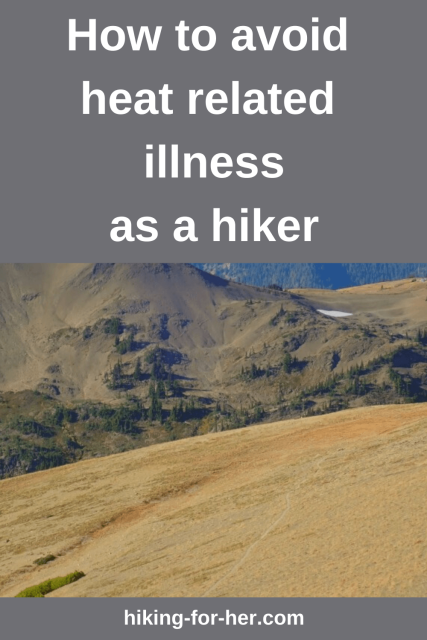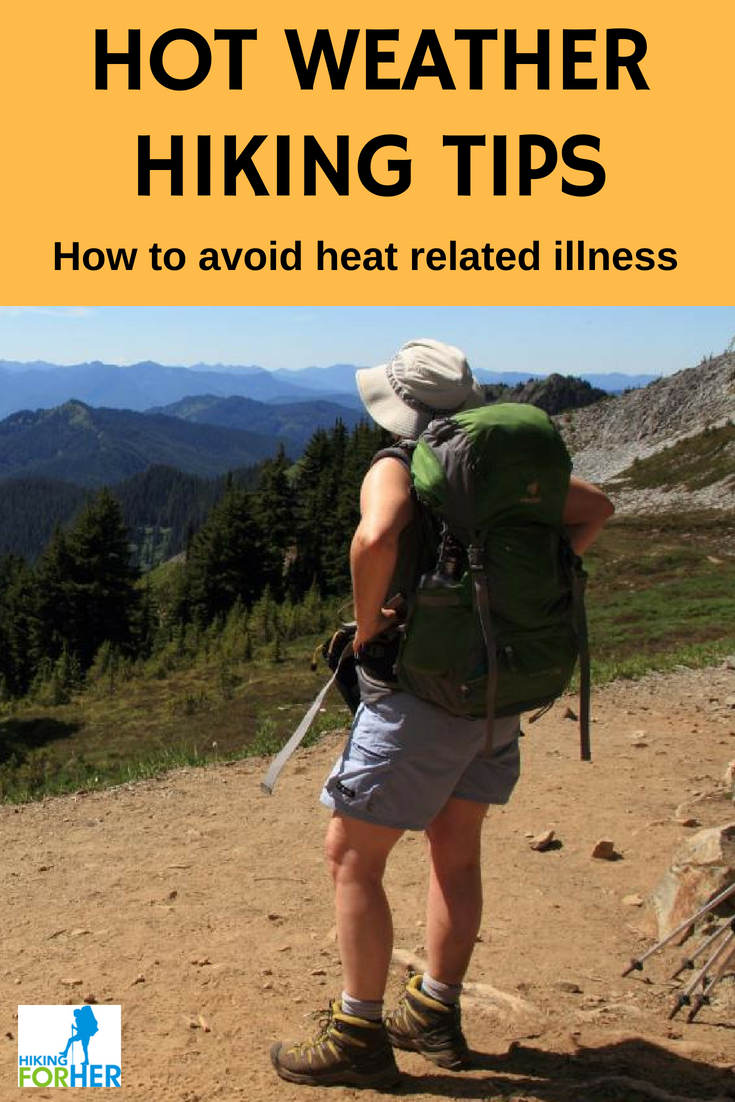
Hot Weather Hiking:
Tips To Avoid And Manage
Heat Related Illness
By Diane Spicer
Hot weather hiking needs a smart approach to keep yourself out of heat related illness scenarios.
This page will help you do just that, with tips on how to use your head and your behavior to keep yourself safe.
However, this is not medical advice. It's up to you to know your own limitations, and take precautions during hot weather hiking.
Hot weather hiking plans?
Use a smart approach
It is understandable that you feel invincible when you're a twenty something athlete, or a hiker who has never faced hot weather hiking conditions.
Sitting in the cool, hydrated comfort of daily life, you may not anticipate some of the trail issues you will face when hiking through heat, humidity, and relentless sunlight.
So I'm here to deliver the news that regardless of who you are, you need a personal plan to avoid heat related illnesses.
Let's begin with awareness of what you're up against when you choose to hike (i.e. exercise) in hot conditions.
Be aware of these
heat related illnesses
Your body has specific feedback mechanisms to tell you when your internal temperature has reached a dangerously high level.
- FYI, it does the same thing when your core temperature drops too low in hypothermia.
Ready for a quick tour of how your body speaks to you when you're enjoying some hot weather hiking?
This information on heat safety can prevent a lot of suffering on the trail, but only if you plan ahead, and take action when needed.
Hot weather hiking:
messages from your skin
When you sweat, you dump excess heat from your body through the openings to the outside of your skin: sweat glands.
- Evaporative cooling at its finest
And you should be *sweating a lot* as you hike on a hot day!
To head off trouble, pay attention to what your skin has to say about all of that sweating.
Heat rashes
Sometimes your sweat glands become blocked, causing what is known as prickly heat, or just plain old heat rash (miliaria).
This bumpy, unpleasant outbreak occurs on areas where your clothing has prevented your sweat glands from working properly, and/or on sun exposed skin where dust and sunscreen accumulates.
For a hiker, that's pretty much everywhere, isn't it!
- This unwelcome development feels like something is crawling across your skin, thus the "prickly".
- It looks like this.
Trail action:
Use anti-itch preparations you are carrying in your hygiene kit, such as calamine or sunburn lotions.
But go easy on them. You don't want to block the sweat glands further.
Trail tip:
If you experience frequent bouts of heat rash, you need moisture wicking clothing for the trail (see below).
Hiker's rash
Guess what?
Hikers get a "special" rash in hot weather, on the lower legs between the sock line and the upper thighs.
Lucky us!
Read more about how to prevent (Plan A) or deal with (Plan B) hiker's rash here.
Lack of perspiration
Doesn't that sound weird on a hot hiking trail?
It is! Don't ignore it.
Here's what's happening to your body:
- Your sweat levels are copious, and along with water you're losing the charged particles called ions (salts) that your nervous system needs to maintain its functions (see below).
- Double whammy: dehydration + salt depletion
This loss is setting you up for exercise-associated heat exhaustion, a vivid description of what your body feels like in this scenario: weak and wiped out.
Here is a fact you cannot ignore if you choose to hike in hot weather conditions:
Heat exhaustion can progress into heat stroke if you ignore it.
There is very little you can do on the trail for someone in this condition, so it is important to spot heat exhaustion immediately, and turn it around while you can.
- Read about the differences between heat exhaustion and heat stroke, and how to take action, here.
Special note to hikers with lung, heart and kidney conditions: you are more prone to this scenario.
Ditto for those on a low sodium or sodium restricted diet.
Always consult your medical care providers before a hot weather hiking trip.
Hot weather hiking:
messages from your nervous system
Your brain works with exquisite timing and control to communicate with your hard working hiking muscles.
It also keeps you alert and aware of trail conditions.
Tune in to subtle changes in these two communication pathways when the day is hot and the hike is long:
- Muscle cramping anywhere in your body
- Light headed or dizzy feelings
- Irritability or headache
- A sensation of nausea or feeling like you're going to vomit
If you're suffering these symptoms, stop moving and assess your condition.
Rely upon a trail buddy for unbiased feedback.
If you're alone, you can summon help if your condition is beginning to deteriorate to the point where you feel incoherent or confused.
- Read about personal locator beacons to decide if you need to have one in your backpack on hot weather hikes.
Hot weather hiking:
messages from your extremities
Your fingers and ankles might swell up during and after a hike, and this may be more pronounced during hot weather hikes.
These tips will help you sort out when peripheral edema (fancy name for swollen extremities) is normal, and when it's time for medical assessment:
Your personal plan for
hot weather hiking
If you live in a hot climate, you don't need to put together a personal plan because you've already had a lot of trial and error trail time.
- Although some of these tips might be new to you.
If you're planning to hike in a hot place and you're unfamiliar with high(er) temperatures, heed these cautions.
Cautions for hot weather hikers
in general
- To answer the question of what to wear hiking in hot weather, read these tips on breathable, moisture wicking hiking clothing designed to keep you as cool and dry as possible.
- Carry a clean absorbent towel like this one to mop up sweat from your face and skin creases.
- Acclimate to hot weather hiking conditions before jumping into these unfamiliar conditions.
- Acquaint yourself with the heat index (free pdf relating temperature with relative humidity) and alter your hiking plans when it's in the danger zone.
- Carry insulated water bottles so your water stays as cool as possible, like these, or freeze your plastic water bottles the night before.
- Bury your water bottles deep within your backpack, out of direct sunlight.
- Or switch to a hydration backpack.
- Plain water probably isn't enough when you're sweating a lot and losing salts, so add electrolytes like these to your water bottles.
- Use the color of your urine to assess whether or not you're fully hydrated; the darker the color, the more water you need to replace immediately.
- Same goes for the amount of urine you are producing; scant amounts mean your body needs more fluids.
- Evaluate whether the hike you want to do is worth the risk of all of the heat related illnesses described here.
- Extra caution is needed if you are taking certain medications or have preexisting medical conditions; loop your medical team into your hiking plans.
- Young and old hikers are more prone to trail problems in the heat, so be conservative with your hiking plans.
Cautions for hot weather day hikers
- Pace yourself with kindness. Don't try to keep up with hikers who push hard and go fast in hot weather: hike your own sensible hike.
- Take your hydration breaks seriously. Set a timer on your watch if necessary to be sure you're drinking frequently.
- Carry salty snacks but avoid loading up on a lot of food all at once.
- Use the long days of summer to start your hike in the cool of early, early morning or late, late afternoon.
- Choose your route and destination to avoid blazing direct sunlight whenever possible.
- This sounds really simplistic, but wear this style of wide brimmed hat with full coverage of your face, ears and neck.
- Sunscreen needs to be reapplied every few hours because you're losing it to sweat and the application of the aforementioned towel. Use only the best!
Cautions for backpackers on hot hiking trips
- Clean, dry clothing can keep you out of trouble with heat rash, so be sure you wash and air dry your underwear, socks and shirts frequently.
- Have a solid plan for surface water access, and verify that your water sources are still there using local authorities, hiking blogs, and trail buddies before you set out on your trip.
- Hike by headlamp in the cool of night whenever it's safe to do so, and steer by the light of a full moon for some fantastic night hiking experiences.
- Pacing is everything. Avoid pulling long uphill slogs in the heat of the day, but if you think you must, reduce your normal hiking pace by half to control your perspiration amounts.
- A hiking umbrella can keep you cooler.
- Stay watchful for the heat related illness signs of trouble, in yourself and your hiking companions, because taking immediate action will prevent an escalation into an emergency rescue situation.
Can hot weather hiking be done safely?
Of course it can!
It just takes the 3 ingredients mentioned at the beginning:
- knowledge
- awareness
- action
Your goal: keeping heat related illness a theory, not an experience, with these hot weather hiking tips!
And never be afraid to change your plans if conditions are too hot to hike. The trail will be there when it cools down.
- More "hot" tips and a complete description of heat exhaustion -vs- heat stroke are here for you.
Home page > Best Hiking Tips >
Hot Weather Hiking Personal Plan To Avoid Heat Related Illness On The Trail
|
I get emails all the time about what I wear, eat, carry and love to use on the trail. That's
why I provide affiliate links to you: the best gear that I use myself and have seen used by other hikers is instantly
available for your consideration, and the gear company sends a few
pennies per dollar to this reader-supported hiking website. There is no added cost to you! Everyone ends up a winner: Great gear for you, strong gear companies, and more free hiking tips for everyone. Thanks very much for your support. It's warmly and sincerely appreciated. It also helps send these hiking tips to all your virtual trail buddies around the globe. |
 |



